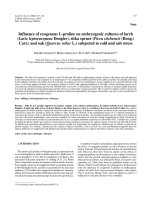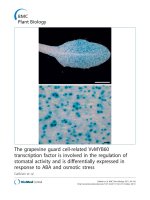50 ways to prevent and manage stress
Bạn đang xem bản rút gọn của tài liệu. Xem và tải ngay bản đầy đủ của tài liệu tại đây (729.82 KB, 161 trang )
This page intentionally left blank.
50 Ways
to Prevent
and Manage
Stress
M. Sara Rosenthal
Chicago New York San Francisco Lisbon London Madrid Mexico City
Milan New Delhi San Juan Seoul Singapore Sydney Toronto
abc
Copyright © 2002 by M. Sara Rosenthal. All rights reserved. Manufactured in the United
States of America. Except as permitted under the United States Copyright Act of 1976, no part of this
publication may be reproduced or distributed in any form or by any means, or stored in a database
or retrieval system, without the prior written permission of the publisher.
0-07-140268-3
The material in this eBook also appears in the print version of this title: 0-7373-0558-4.
All trademarks are trademarks of their respective owners. Rather than put a trademark symbol after
every occurrence of a trademarked name, we use names in an editorial fashion only, and to the benefit
of the trademark owner, with no intention of infringement of the trademark. Where such designations
appear in this book, they have been printed with initial caps.
McGraw-Hill eBooks are available at special quantity discounts to use as premiums and sales promotions, or for use in corporate training programs. For more information, please contact George
Hoare, Special Sales, at or (212) 904-4069.
TERMS OF USE
This is a copyrighted work and The McGraw-Hill Companies, Inc. (“McGraw-Hill”) and its licensors
reserve all rights in and to the work. Use of this work is subject to these terms. Except as permitted
under the Copyright Act of 1976 and the right to store and retrieve one copy of the work, you may not
decompile, disassemble, reverse engineer, reproduce, modify, create derivative works based upon,
transmit, distribute, disseminate, sell, publish or sublicense the work or any part of it without
McGraw-Hill’s prior consent. You may use the work for your own noncommercial and personal use;
any other use of the work is strictly prohibited. Your right to use the work may be terminated if you
fail to comply with these terms.
THE WORK IS PROVIDED “AS IS”. McGRAW-HILL AND ITS LICENSORS MAKE NO GUARANTEES OR WARRANTIES AS TO THE ACCURACY, ADEQUACY OR COMPLETENESS OF
OR RESULTS TO BE OBTAINED FROM USING THE WORK, INCLUDING ANY INFORMATION THAT CAN BE ACCESSED THROUGH THE WORK VIA HYPERLINK OR OTHERWISE,
AND EXPRESSLY DISCLAIM ANY WARRANTY, EXPRESS OR IMPLIED, INCLUDING BUT
NOT LIMITED TO IMPLIED WARRANTIES OF MERCHANTABILITY OR FITNESS FOR A
PARTICULAR PURPOSE. McGraw-Hill and its licensors do not warrant or guarantee that the functions contained in the work will meet your requirements or that its operation will be uninterrupted or
error free. Neither McGraw-Hill nor its licensors shall be liable to you or anyone else for any inaccuracy, error or omission, regardless of cause, in the work or for any damages resulting therefrom.
McGraw-Hill has no responsibility for the content of any information accessed through the work.
Under no circumstances shall McGraw-Hill and/or its licensors be liable for any indirect, incidental,
special, punitive, consequential or similar damages that result from the use of or inability to use the
work, even if any of them has been advised of the possibility of such damages. This limitation of liability shall apply to any claim or cause whatsoever whether such claim or cause arises in contract, tort
or otherwise.
DOI: 10.1036/0071402683
Contents
Acknowledgments vii
Introduction ix
PART ONE
Downshifting
1. Recognize How Hard You Work 1
2. At Least Try to Do What You Love 4
3. Reduce the Commute 7
4. Reduce Your Workweek 9
5. Renegotiate Vacation and Leave Time 9
6. Rid Yourself of E-Stress 10
7. Eliminate Energy Drains 14
8. Reduce Your Snail Mail and Plastic 16
9. Restructure Your Finances 18
10. Stop the Insanity: Stress Relief
for Parents 19
iii
McGraw-Hill's Terms of Use
iv
Contents
PART TWO
Hands-On Healing
11. Discover Your Life-Force Energy 25
12. Get a Massage 27
13. Consider a Chiropractor 29
14. Discover Osteopathic Manipulation 30
15. Consider Pressure-Point Therapies 31
16. Stand and Deliver: Postural Reeducation
Strategies 34
17. Try Rolfing: Structural Integration 35
18. Know Where to Find (and How to Use)
Hands-On Healers 36
19. Learn to Give (and Receive) a
Proper Back Rub 37
20. Learn to Work Your Own
Pressure Points 37
PART THREE
A ntistress Herbs and Nutrients
21. Calm Your Nerves with Herbs 39
22. Consider Aromatherapy 43
23. Take These to Heart 43
24. Lower Your Risk of Heart Attack or Stroke
with Herbs and Nutrients 45
25. Give Your Immune System a Boost 46
26. Combat Digestive Disorders with
Herbs and Spices 48
27. Eat Well to Reduce Stress 49
Contents
28. Avoid Overeating 56
29. Supplement Your Diet with
Antistress Vitamins 59
30. Avoid Stress Aggravators 61
PART FOUR
Inner and Outer A ntistress Workouts
31. Get Moving 69
32. Make Stress-Fighting Endorphins 70
33. Develop an Action Plan 71
34. Know When to Consult a Fitness
Practitioner/Trainer 74
35. Practice Yoga 75
36. Try Deep-Breathing Exercises to
Relieve Stress 75
37. Meditate for Stress Relief 77
38. Try Qi Gong Exercises 78
39. Stretch to Relieve Stress 79
40. Try Antistress Postures to
Improve Digestion 80
PART FIVE
Self-Care
41. Get More Sleep 83
42. Get Creative 84
43. Try Feng Shui 86
44. Avoid Loneliness 87
45. Consider Counseling 88
v
vi
Contents
46. Rule Out Biological Causes for Burnout 94
47. Pamper Yourself 101
48. Enjoy Your Food 102
49. Limit Your Exposure to Food Toxins 103
50. Cry More, Laugh More, and Learn
to Forgive 106
Epilogue 108
Bibliography 109
Resources 121
Links 131
Index 137
Acknowledgments
I wish to thank the following people, whose expertise on
past works helped to lay so much of the groundwork for this
book: Gillian Arsenault, M.D., C.C.F.P., I.B.L.C., F.R.C.P.;
Pamela Craig, M.D., F.A.C.S., Ph.D.; Masood Kahthamee,
M.D., F.A.C.O.G.; Debra Lander, M.D., F.R.C.P.C.; Mark
Lander, M.D., F.R.C.P.C.; Sheila Lander, L.P.N./R.N.;
Gary May, M.D., F.R.C.P.; James McSherry, M.B., Ch.B.,
F.C.F.P., F.R.C.G.P., F.A.A.F.P., F.A.B.M.P.; Suzanne Pratt,
M.D., F.A.C.O.G.; Wm. Warren H. Rudd, M.D.,
F.R.C.S.(C.), F.A.C.S., Fellow, A.S.C.R.S.; and Robert
Volpe, M.D., F.R.C.P., F.A.C.P. Larissa Kostoff, my editorial consultant, worked very hard to help bring this book
into being. Finally, Hudson Perigo, my editor, offered many
wonderful and thoughtful suggestions to help make this
book what it is.
vii
Other books by M. Sara Rosenthal:
The Thyroid Sourcebook
The Gynecological Sourcebook
The Pregnancy Sourcebook
The Fertility Sourcebook
The Breastfeeding Sourcebook
The Breast Sourcebook
The Gastrointestinal Sourcebook
Managing Your Diabetes*
Managing Diabetes for Women*
The Type 2 Diabetic Woman
The Thyroid Sourcebook for Women
Women and Sadness*
Women and Depression
Women of the ’60s Turning 50*
Women and Passion*
50 Ways to Prevent Colon Cancer
50 Ways Women Can Prevent Heart Disease
50 Ways to Manage Heartburn, Reflux, and Ulcers
50 Ways to Manage Type 2 Diabetes
50 Ways to Prevent Depression
SarahealthGuides® (These are M. Sara Rosenthal’s own line of health
books dedicated to rare, controversial, or stigmatizing health topics; they
are available only at online bookstores such as amazon.com.):
Stopping Cancer at the Source
Women and Unwanted Hair
*(in Canada only or online through www.chapters.ca)
Introduction
What Is Stress?
Generally, stress is a negative emotional experience associated with biological changes that trigger your body to make
adaptations. For example, in response to stress, your adrenal
glands pump out stress hormones that speed up your body.
Your heart rate increases, and your blood sugar levels rise
so that your body can divert glucose to your muscles in case
you have to f lee dangerous situations. Together, these
changes are known as the fight or flight response. The stress
hormones, technically called the catecholamines, are broken
down into epinephrine (adrenaline) and norepinephrine.
The problem with stress hormones in the twenty-first
century is that the fight or f light response is rarely necessary. Today most stress stems from interpersonal situations
rather than from attacks by a predator. Occasionally, you
may want to f lee from a bank robber or mugger, but most
of us just want to f lee from our jobs or our kids! As a result,
your stress hormones actually put a physical strain on your
body and can lower your resistance to disease. Initially,
ix
x
Introduction
stress hormones stimulate your immune system, but after
the stressful event has passed, they can suppress the
immune system, leaving you open to a wide variety of illnesses and physical symptoms.
Hans Selye, considered the father of stress management,
defined stress as the wear and tear on the body. Once you
are in a state of stress, the body adapts to the stress by
depleting its resources until it becomes exhausted. The wear
and tear on your body is mounting; you can suffer from
stress-related conditions:
• Allergies and asthma
• Back pain
• Cardiovascular problems
• Dental and periodontal problems
• Depression
• Emotional outbursts (rage, anger, crying,
irritation—seen in recent reports on “air rage” and
“desk rage”)
• Fatigue
• Gastrointestinal problems (digestive disorders,
bowel problems, and so on)
• Headaches
• Herpes recurrences (especially in women)
• High blood pressure
• High cholesterol
• Immune suppression (predisposing us to viruses,
such as colds and f lu, infections, autoimmune
disorders, and cancer)
Introduction
• Insomnia
• Loss of appetite and weight loss
• Muscular aches and pains
• Premature aging
• Sexual problems
• Skin problems and rashes
As you can see from this lengthy list, stress greatly contributes to ill health and disease. Addictions and substance
abuse may fuel many of these problems when you try to
relieve your symptoms or self-medicate. Current statistics
reveal that 43 percent of all adults suffer from health problems directly caused by stress, while 70 to 90 percent of all
visits to primary-care physicians are for stress-related complaints or disorders. In the workplace alone, about a million
people per day call in sick because of stress. That rate translates into about 550 million absences per year. Other studies show that roughly 50 percent of all North American
workers suffer from burnout—a state of mental exhaustion
and fatigue caused by stress—and that 40 percent of
employee turnover is directly caused by stress.
The financial toll of occupational stress on North American industry adds up to about $300 billion annually. This
figure includes costs of absenteeism, lower productivity,
employee turnover, and direct medical, legal, and insurance
fees. California employers alone spend about $1 billion for
medical and legal fees due to stress. Ninety percent of job
stress lawsuits are successful, and the resulting fines are
four times those for other injury claims. Meanwhile, corporate spending on stress management programs grew from
$9.4 billion in 1995 to $11.3 billion in 1999.
xi
xii
Introduction
The consequences of stress can be worse than these
financial ones. Terrible industry accidents such as oil spills
or nuclear reactor accidents are considered to be caused—
60 to 80 percent of the time—by overstressed workers.
Terms such as office rage and desk rage are emerging, too, as
workplace violence escalates. A more subtle but compelling
statistic is this: In 1997, the Japanese word karoshi, which
means sudden death from overwork, began appearing in
English dictionaries.
Types of Stress
Managing your stress is no easy feat, particularly since
there are different types of stress: acute stress and chronic
stress. Acute stress results from an acute situation, such as
a sudden, unexpected negative event or a difficult task like
organizing a wedding or planning for a conference. When
the event passes or the task ends, the stress goes away.
Acute stress has numerous symptoms: anger or irritability,
anxiety, depression, tension headaches or migraines, back
pain, jaw pain, muscular tension, digestive problems, cardiovascular problems, and dizziness.
Acute stress can be episodic, meaning that one stressful
event follows another, creating a continuous f low of acute
stress. Someone who is always taking on too many projects
at once may suffer from episodic acute stress, rather than
simply acute stress. Workaholics and those with the socalled Type A personality (i.e., perfectionists) are classic sufferers of episodic acute stress.
I sometimes refer to acute stress as the good stress. Often,
good things come from this kind of stress, even though it
feels stressful or bad in the short term. Acute stress chal-
Introduction
lenges us to stretch ourselves beyond our capabilities. It is
what makes us meet deadlines, push the outside of the envelope, and invent creative solutions to our problems. Consider a few examples of good stress:
• Challenging projects
• Positive life-changing events (moving, changing jobs,
or ending unhealthy relationships)
• Confronting fears, illnesses, or people that make us
feel bad
These situations can be difficult to endure, but often the
outcome is good for us in the long term.
Essentially, whenever a stressful event triggers emotional,
intellectual, or spiritual growth, it is a good stress. It is often
not the event itself but your response to the event that determines whether it is a good or bad stress. Even the death of a
loved one can sometimes lead to personal growth. For example, we may see something about ourselves we did not see
before, such as new resilience. In this case, grieving a death
can be a good stress, though we are sad in the short term.
What I call the bad stress is known as chronic stress.
Chronic stress results from boredom and stagnation, as well
as prolonged negative circumstances. Essentially, when no
growth occurs from the stressful event, it is bad stress.
When negative events don’t seem to yield anything positive
in the long term, but more of the same, the stress can lead
to chronic and debilitating health problems. Some examples
of bad stress include stagnant jobs or relationships, disability from terrible accidents or diseases, long-term unemployment, chronic poverty, racism, or lack of opportunities
for change. These kinds of situations can lead to depression,
low self-esteem, and a host of physical illnesses.
xiii
xiv
Introduction
In addition to acute and chronic stress, stress can be
defined in even more precise ways:
• Physical stress (from physical exertion)
• Chemical stress (from exposure to a toxin in the
environment, including from substance abuse)
• Mental stress (from taking on too much
responsibility and worrying about all that has to be
done)
• Emotional stress (from feelings such as anger, fear,
frustration, sadness, betrayal, or bereavement)
• Nutritional stress (from deficiency in certain
vitamins or nutrients, overindulgence in fat or
protein, or food allergies)
• Traumatic stress (from trauma to the body such as
infection, injury, burns, surgery, or extreme
temperatures)
• Psychospiritual stress (from unrest in your personal
relationships or belief system, personal life goals,
and so on—in general, the factors that define
whether or not you are happy)
The bottom line is that stress can make you sick. This book
is designed to help you reorganize your priorities so that
you can reduce chronic stress as well as incorporate a few
new healing strategies to help combat acute stress. Finding
ways to downshift (Items 1 through 10) while incorporating hands-on healing (Items 11 through 20), herbs and
nutrients (Items 21 through 30), inner and outer workouts
(Items 31 through 40), and self-care (Items 41 through 50)
into your daily routine may dramatically reduce your current stresses.
PART ONE
Downshifting
1. Recognize How Hard You Work
Downshifting is a term that emerged in the early 1990s to
mean slowing down. The first step in downshifting is to recognize the need to do so. You may not be aware of how much
stress you endure by simply working in the nine-to-five
workplace (which is more like five to nine for many) that
still exists in most offices. The workplace is a volatile stress
factory for most employees. One reason is the constant threat
of losing your job, as mergers and downsizing have
increased job stress for millions. Another source of stress is
the unspoken pressure to put in face time, or hang around
the office longer to look like you’re productive and dedicated, even though no one has directly told you to stay. Factor in new bosses, computer surveillance, and fewer health
and retirement benefits, and it’s easy to see how workplace
stress can affect your personal life.
One of the most significant factors in job stress is a sense
of powerlessness over your job or duties. Secretaries, waitresses, middle managers, police officers, editors, and med1
McGraw-Hill's Terms of Use
2
50 Ways to Prevent and Manage Stress
ical interns are considered high-stress positions because
these jobs entail a lot of responsibility but little authority.
Another stressful mismatch is to be a poet in a desk job—
that is, to be a highly creative person performing an unchallenging job to pay the rent. For example, are you an actor
by night and a bookkeeper or receptionist by day?
A number of studies note that when you don’t control
decision making in your workplace, you endure more
chronic stress. Although acute stress often comes with the
responsibility of making decisions, people are more motivated and challenged creatively when they feel their opinions or decisions are valued.
Jobs also may cause trauma. Criminal justice personnel,
firefighters, ambulance drivers, military personnel, and disaster teams witness horrific scenes each day. Physicians,
caregivers, social workers, and therapists experience vicarious traumatization, meaning that they are traumatized by
what they see and hear through their clients each day. Even
ordinary jobs can be traumatic when clients emotionally or
physically threaten you.
The workplace itself can be stressful to your physique if
it is hazardous or toxic in some way. In 1995, Dr. Peter
Inante, Director of the Office of Standards Review, Occupational Safety and Health Administration of the U.S.
Department of Labor, stated that blue-collar workers
“appeared to be the canaries in our society for identifying
human chemical carcinogens in the general environment.”
Known carcinogens at the office (or home) may be found
in many places:
• Asbestos building materials
• Cleaning products and disinfectants
Downshifting
• Urea-formaldehyde foam insulation
• Adhesives (may contain naphthalene, phenol,
ethanol, vinyl chloride, formaldehyde, acrylonitrile,
and epoxy, which are toxic substances that release
vapors)
• Toners used in copy machines and printers
• Particleboard furniture and space dividers
• Permanent-ink pens and markers (contain acetone,
cresol, ethanol, phenol, toluene, and xylene)
• Polystyrene cups
• Secondhand smoke
• Synthetic office carpet (may contain acrylic,
polyester, and nylon plastic fibers and formaldehydebased finishes) or wool carpet (may contain
pesticides for mothproofing)
• Correction f luid, such as Wite-Out or Liquid Paper
brands (may contain cresol, ethanol,
trichloroethylene, and naphthalene, which are all
toxic chemicals)
You’re more likely to be affected by workplace carcinogens if you are subject to one or more of the following
conditions:
• Work or live in energy-sealed buildings
• Are exposed to fumes from carpets, pesticides,
cleaners, and airborne allergens
• Are exposed to industrial chemicals, such as those
found in plants that process wood, metal, plastics,
paints, and textiles
3
4
50 Ways to Prevent and Manage Stress
• Are in constant contact with pesticides, fungicides,
and fertilizers
• Live in high-pollution areas
• Work in dry cleaning, hair styling, pest control,
printing, or photocopying
For more information, you can go to the NIOSH-TIC
database, maintained by the National Institute for Occupational Safety and Health (NIOSH) and available on the
Internet. You can also call NIOSH Information Dissemination at (513) 533-8287. Other government agencies with
relevant information are the Centers for Disease Control
and Prevention (CDC) in Atlanta, Georgia—(404) 6393311—and the Occupational Safety and Health Administration (OSHA), which is the federal agency in charge of
workplace safety and health.
2. At Least Try to Do What You Love
If you do what you love, you’ll love what you do. And you’ll
feel so much better, even though you may not make as much
money. Surveys and studies show across the board that
daily going to a job you hate creates stress.
Doing what you love doesn’t necessarily mean throwing
in the towel and moving to France so you can paint for the
rest of your life. It means exploring what you’re good at
(and/or enjoy doing) to see if there’s a way you can earn an
income from it. For example, can you take courses that
would allow you to enter a field you prefer? The promise
of a more satisfying future achieved with the right credentials often reduces chronic stress arising from the prospect
of the same old same old. Although expanding your educa-
Downshifting
tion or training may involve some short-term stress from the
added responsibilities, in the long term it gives you a more
hopeful future, which in turn will reduce stress.
Sometimes doing what you love means accepting that
you’re not very good at management and would prefer a
nonmanagerial position. For many people, the solution is to
work in the store instead of running it. On the f lip side, you
may find that doing what you love means facing the fact
that you are a leader and find it stressful to be in a subordinate position. In this case, perhaps starting your own company (where you have control) may be less stressful, even
though it involves far more responsibility. Although many
have failed, there are still some who have found success
starting Internet businesses and home-based businesses,
taking advantage of new technologies and access to a global
market through the Internet. Another way to satisfy a craving for control or leadership is to move to positions in large
companies that allow you to start a new venture as an
“intrapreneur,” or a manager with an entrepreneur’s authority. Millions of other independent-minded employees work
as traveling salespeople, who receive a gas or car allowance
and work mostly on commission with a small base salary.
These positions offer the f lexibility and the control of
lifestyle that can enable employees to feel autonomous.
Some people can’t support themselves by doing what
they love, so they downshift by moving to a simple side job
with f lexible hours. The side job pays the bills, and the f lexible schedule allows time for art or another main interest.
Couriers, postal workers, restaurant servers, and so forth
frequently have more artistic lifestyles. If a job simply supports your art, it is less important than a job that is part of
your career. A side job is less stressful because it doesn’t
5
6
50 Ways to Prevent and Manage Stress
consume your life. If you lose one side job, it’s easy to get
another. In other words, side jobs involve detachment, while
career-jobs involve attachment and far more emotional
investment. Sometimes doing what you love means facing
up to the fact that your dream job or profession has become
a living nightmare. This is not an easy thing to admit,
because it often demands a major change. For example,
imagine an overworked medical resident in a busy university teaching hospital. When she admits she spends most of
her time filling out insurance paperwork, she decides that
she’s packing up and becoming a country doctor in an
underserviced rural area. She won’t become the brilliant
heart surgeon her family dreamed of; she won’t earn
$350,000 per year, not including the conference perks.
Instead, she’ll settle for a third of that salary in a rural setting where the housing is affordable and people say hello to
her.
Pursuing what you love involves four steps:
1. Ask yourself whether you’re happy with your choice
of job or career. Being happy is not the same thing
as feeling stable or not miserable. If you’re not happy,
persisting in a state of unhappiness is unhealthy.
2. Make a list of dream jobs or careers, no matter how
silly you think you’re being. Always wanted to be a
dancer, but are making a living in marketing? Maybe
you can pursue administrative or marketing jobs with
a dance company or dance theater. Maybe you can
write about dance or start a children’s dance school.
Always wanted to be a farmer? Why not? Organic
farming is booming! Dream jobs can also mean parenting. If being a stay-at-home parent is your dream,
it’s worth pursuing, too.
Downshifting
3. Assess whether you hate your profession, or just your
job or locale. How portable is your profession? If you
have a job that’s in demand everywhere, like Webmaster, writer, or teacher, find a more suitable city
or town to live in, and just start working. The Internet can make many careers portable. Are you a
burned-out secretary? Start your own secretarial services company on the Web. (If there isn’t a “secretary.com” yet, someone should start one!)
4. Talk to your family members, and seek their support
to pursue something else. If your family members are
not behind you, pursuing what you love may be more
difficult and may make you face deep questions about
your emotional support system. Pursuing your dreams
sometimes requires leaving relationships or marriage.
In assessing what you want, you may discover that all
these years, you’ve been living behind a mask or simply going through the motions of your existence.
3. Reduce the Commute
One of the simplest ways to destress and downshift is to
eliminate that stressful commute. If you live in a bedroom
community and drive into an urban center, you may be
spending more than an hour each way, to and from work.
Driving is stressful, and reducing the drive can reduce a lot
of stress. Here are some ways to reduce your commute:
• If you spend most of your time at work on the
computer or on the phone, try to negotiate
telecommuting with your employer. This means
being plugged into the office from home. With
7
8
50 Ways to Prevent and Manage Stress
teleconferencing tools, there’s little reason to actually
go into an office these days. Your employer can save
on overhead because of the office space you’ll free
up, and the f lexibility may attract more loyal
employees.
• Look into moving closer to work. If you calculate
your car expenses, gas expenses, and so on, moving
within walking distance to work may be the answer.
Many people find trading a house in the suburbs for
a rental in the city makes more sense financially.
Rent and no car often equal far less than a mortgage
and two cars! Car rentals for weekends away and
the occasional taxi still add up to less than car lease
payments, car financing payments, car repairs, gas,
maintenance, and insurance.
• If there’s no way you can move, no way your
employer will let you work from home, and you’re
working very late hours anyway, consider renting a
small apartment or room within walking distance of
your office. Leave the car at the office weekdays,
and crash in your small city space. Drive home for
the weekends. Of course, if this creates more stress,
don’t do it, but a lot of commuters are finding a
small city crash pad has other advantages. You can
extend the “pad” to visiting friends or relatives
(often hosting visitors creates more stress!), and
other family members can use the pad when they
have to be in the city for extended periods of time.
Sometimes marriages and long-term relationships
benefit when there’s a place to go for personal space
or distance in high-stress times.
Downshifting
4. Reduce Your Workweek
Moving down from a five-day workweek to a four-day
workweek greatly reduces stress for many. Psychologically,
working Tuesday to Friday eliminates Mondays. According
to Deepak Chopra, more people have heart attacks Monday mornings than any other time. Another popular choice
is to work Monday to Thursday, giving you an early start
to your weekend. If you’re a valued employee, many
employers would rather have you working four days for
them than not at all. When you calculate the time it takes
to train someone else, it’s more costly to replace you than
to give you a four-day week. You simply reduce your salary
to accommodate your new workweek.
Another way to negotiate a reduced workweek is to use
vacation and sick days as Mondays off for a year. Some executives have accumulated weeks of unused vacation time,
which they can use for reduced workweeks. In some companies, being away from the office for long periods of time
actually creates more stress and guilt for the employee. Taking a day off each week may be one solution to “vacationitis.”
You might also be able to reduce your workweek by finding someone else at work who wants to share a job. Surveys
show that most people would trade full-time hours for parttime hours if they could have job security.
5. Renegotiate Vacation and Leave Time
In a study of 12,338 men ages thirty-five to fifty-seven, the
American Psychosomatic Society found that men who took
annual vacations were 21 percent less likely to die during
the sixteen-year study period than were nonvacationers—
9









